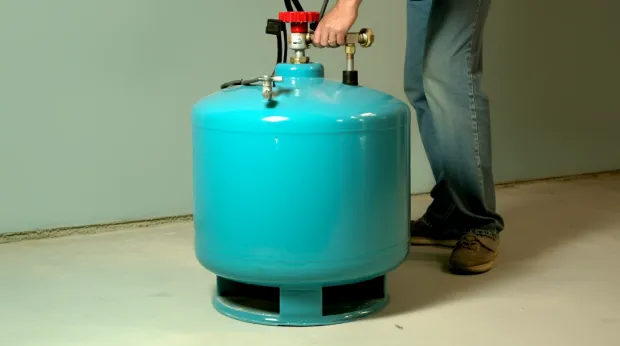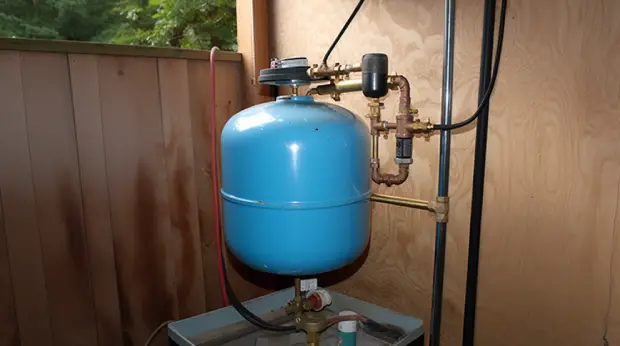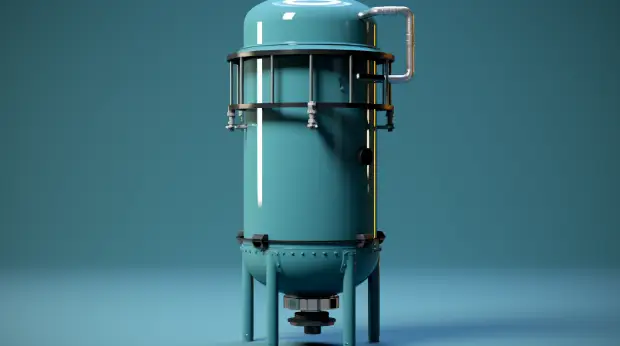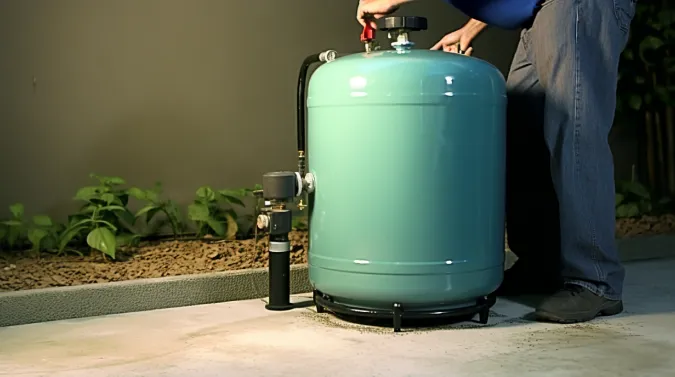Last Updated on August 16, 2023
Expansion tank sizing for a well pump system ensures optimal water pressure and the longevity of your system. If you’re looking to set up or improve your well pump setup, understanding how to size the expansion tank correctly is essential.
To size an expansion tank for your well pump, you’ll need to calculate the drawdown capacity, the amount of water the tank can hold between pump cycles.
This involves knowing your pump’s flow rate, determining the minimum runtime based on pressure switch settings, and applying these values to the drawdown capacity formula.
Then, you need to match the calculated drawdown capacity with available tank sizes, so you can pick the right tank to minimize frequent pump cycling.
We’ll guide you through the step-by-step process of sizing an expansion tank, enabling you to make smart choices regarding the efficiency and durability of your well pump system.
How to Size Expansion Tank for Well Pump: Step-By-Step Guide

To properly size an expansion tank for a well pump, there are four key steps you need to follow. The following are among them:
- Step 1: Understand the basics
- Pressure tanks and drawdown
- Pressure switch settings
- Flow rate
- Minimum runtime
- Step 2: Calculate drawdown capacity
- Step 3: Determine tank size
Let’s examine each step in detail, so you can determine the appropriate size of an expansion tank for a well pump.
Step 1: Understand the Basics
In order to understand how to size, you should first understand a few key concepts. These are:
Pressure Tanks and Drawdown: A pressure tank holds water and compressed air. Only about a third of the tank actually holds water, while the rest is filled with compressed air. When water pressure is needed, compressed air provides it.
The drawdown is the usable amount of water in the tank that can be used before the pressure drops enough to turn the pump back on.
Pressure Switch Settings: The pressure switch monitors the pressure in the tank and controls when the well pump turns on and off.
It usually has two settings, such as 30/50 or 40/60. The first number indicates the pressure at which the pump turns on, and the second number represents the pressure at which the pump turns off.
Flow Rate: The flow rate refers to how many gallons of water your pump produces per minute. It’s typically measured when a new well is drilled.
Minimum Runtime: The minimum runtime is the duration it takes for the pump to provide the desired drawdown capacity. This is determined by the pressure switch setting.
Step 2: Calculate Drawdown Capacity
To size the expansion tank, you’ll need to calculate the drawdown capacity. This refers to the amount of water that can be used before the pump needs to turn on again.
To calculate drawdown capacity, you’ll need to use the formula: Drawdown Capacity = Pump Flow Rate × Minimum Run Time.
In the case of a well pump with a flow rate of 15 GPM and a pressure switch set at 30/50, the minimum runtime can be determined using the pressure switch setting.
This means that the pump will start at 30 PSI and stop at 50 PSI. Using this information, you can calculate the drawdown capacity by multiplying the pump flow rate by the minimum run time.
For this example, the calculation would look like this: Drawdown Capacity = 15 GPM × 20 seconds (approx.) = 300 gallons.
Step 3: Determine Tank Size
Once you’ve calculated the drawdown capacity, it’s time to choose the appropriate tank size that can accommodate this capacity.
Tank sizes typically come in options like 20, 30, 50, 85, and 120 gallons. It’s important to note that the tank’s actual volume is greater than its drawdown capacity, as only about a third of the tank is used for storing water.
To choose the correct tank size, refer back to your calculated drawdown capacity. For example, if your drawdown capacity is 300 gallons, you would need a tank size that can accommodate this amount.
Based on common tank sizes, a 20-gallon, 30-gallon, or even a 50-gallon tank would be insufficient. You would need to choose an 85-gallon or 120-gallon tank. By following this calculation, you will be able to select your well-pump expansion tank.
Additional Factors to Consider When Sizing an Expansion Tank for a Well Pump System

For the purpose of determining the size of an expansion tank for a well pump system, several additional factors need to be considered. These are:
- Household Size and Water Usage
The number of people living in your home and their water consumption habits are important considerations when selecting your well pump expansion tank. Here are four key considerations:
Occupants: Take into account the number of people residing in your home. More occupants typically mean higher water demand, especially during peak usage times like mornings and evenings.
Bathrooms: The number of bathrooms in your home affects the simultaneous water usage. If multiple bathrooms are being used simultaneously, you may need a larger expansion tank to handle the increased demand.
Appliances: Consider the appliances in your home that require water, such as washing machines and dishwashers. These can contribute to higher water usage and may require a larger expansion tank to maintain consistent water pressure.
Fixtures: The number of fixtures, such as taps, showers, and toilets, also impacts water consumption. More fixtures mean greater potential for simultaneous usage, which may necessitate a larger expansion tank to accommodate the demand.
- Distance from Well to Tank
Installing a larger expansion tank can help compensate for pressure loss caused by the distance between your well pump and the tank.
When the distance between the two is greater, the friction in the pipes can lead to a drop in pressure. This can negatively impact the performance of your well pump system, especially in larger properties or systems with complex plumbing layouts.
By choosing a larger expansion tank, you can ensure enough water is stored to maintain adequate pressure throughout your home.
The increased volume of the tank allows for more water to be stored, which helps counterbalance the pressure loss caused by the distance.
This way, you can maintain optimal water pressure and ensure efficient operation of your well pump system.
- Type of Pump
Different types of pumps have varying flow rates and operational characteristics. Submersible pumps, for example, tend to operate at higher speeds and may require larger tanks to accommodate their output.
Submersible pumps push water more effectively, but they can also lead to quicker pressure drops if the tank isn’t adequately sized.
Conversely, jet pumps might require smaller tanks due to their lower flow rates and different operational behavior.
- Constant Pressure Systems
If you’re considering implementing a constant pressure system, which aims to provide uniform water pressure regardless of usage, you’ll need to factor in the requirements of this setup.
Constant pressure systems often rely on additional equipment, like variable frequency drives (VFDs) or cycle stop valves (CSVs), which can affect the sizing of the expansion tank.
These components play a crucial role in maintaining consistent water pressure throughout your system, ensuring a reliable water supply. These systems can provide consistent pressure and optimize pump operation, but they require careful consideration when determining tank size.
Can you oversize a well pressure tank?
You cannot oversize a well pressure tank. In fact, a larger tank is beneficial as it leads to longer and slower cycles, reducing wear and tear on the system.
This results in fewer pump startups and longer run times, ultimately increasing the longevity of the tank.
The main drawbacks of a larger tank are higher costs and space requirements, along with a minor possibility of the tank drawing water faster than the well can supply.
Therefore, if space and cost considerations are not a concern, opting for a larger tank is advantageous.
Conversely, having a tank that is too small can lead to rapid pump cycling, shortening the tank’s lifespan and necessitating premature replacement.
How many pounds of pressure should be in a well pressure tank?

The appropriate pressure within a well pressure tank varies based on the tank’s pressure settings. Typically, well tanks are factory-set at pressure ratios like 30/50 or 40/60.
If the pressure switch is set at 30/50, the well pump’s cut-on pressure is 30 psi, leading to a tank pressure of around 28 PSI.
On the other hand, when using a 40/60 pressure switch, the ideal tank pressure would be approximately 38 PSI.
These pressure settings ensure the efficient functioning of the well system, allowing it to maintain consistent water pressure throughout its operation.
Correctly Size Your Well-Pump
It is now apparent that you possess a comprehensive understanding of how to determine the size of an expansion tank for your well pump system.
By following the step-by-step guide, you’ll ensure optimal water pressure, system longevity, and efficient operation.
Remember the crucial factors: pressure tanks, drawdown, pressure switch settings, flow rate, and minimum runtime. Calculate the drawdown capacity accurately using the formula and determine the appropriate tank size to match it.
Consider household size, distance from well to tank, pump type, and constant pressure systems.
Embrace the benefits of a larger tank for extended cycle life. With this knowledge, you’re equipped to make informed choices for a well-functioning, durable well-pump setup.


